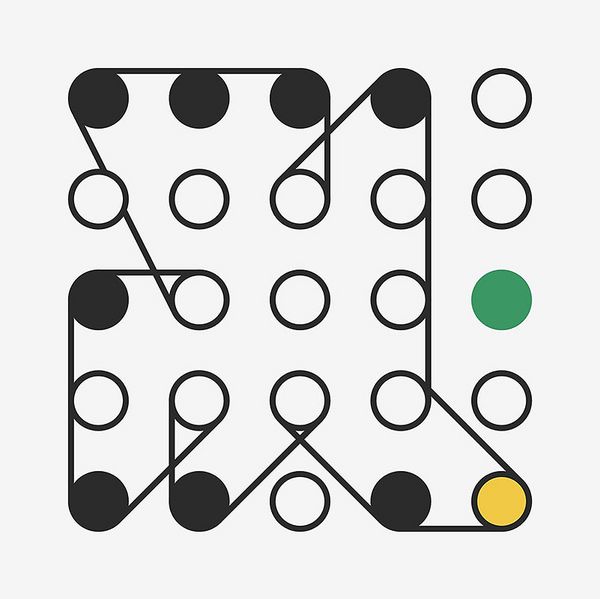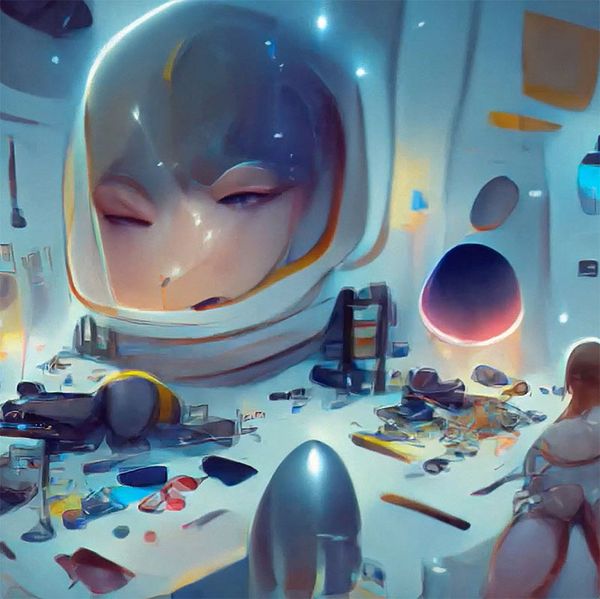Snowfro, Chromie Squiggle #9304, 2022. Ex-Machina: A History of Generative Art.
Written by Georg Bak
The new age of information technology began with the invention of the Turing machine and the first mainframe computers by Konrad Zuse during and after the Second World War. As early as the late 1940s, Norbert Wiener and Claude Shannon formulated the first theoretical approaches to cybernetics, which form important foundations for information aesthetics. The binary system, electronic communication, algorithms and early programming languages also inspired artists. Herbert W. Franke is among the pioneers of computer art, who created works of art – so‐called oscillograms – with analogue computing systems and cathode ray oscillographs in the mid‐1950s. On the control panel, he turned, calculated and manipulated, and sine curves and sawtooth curves, which were photographed with the camera, were superimposed on the screen. Even then there was a group of artists who were open to new technology. Large corporations, namely Olivetti, Siemens and Bell Laboratories, provided them with electronic engineering equipment and the know‐how of their specialists.
Looking back, 1968 is considered the high point of the computer art movement. At the Institute of Contemporary Art (ICA), London, Jasia Reichardt curated the groundbreaking group exhibition Cybernetic Serendipity, featuring computer‐animated films, plotter graphics, generative music, robots and painting machines. Among the participating artists were Frieder Nake, Georg Nees, Desmond Paul Henry, and Vera Molnar. As a result, the Computer Art Society and the computer art magazine PAGE, edited by Gustav Metzger, were founded in London. Today, the Victoria & Albert Museum in London preserves a large part of the heritage of this period of promoterism. Abraham A. Moles opened the Computers and Visual Research symposium as a parallel event as part of the Nove Tendencije (New Tendencies) exhibition series in Zagreb, as well as a small accompanying exhibition with computer graphic by Charles Csuri, Vladimir Bonacic, and other artists. As a result, a major new art magazine, bit international (1968‐1972), was launched in Zagreb.

Dmitri Cherniak, Ringers #29, 2021. Ex-Machina: A History of Generative Art.
At the same time, the German photographer Gottfried Jäger introduced the concept of generative photography with the exhibition of the same name in the Städtische Kunsthaus in Bielefeld, where his pinhole structures can be seen together with works by Kilian Breier (photograms), Pierre Cordier (chemigrams), and Hein Gravenhorst (photomechanical transformations). Gottfried Jäger defined the production principle common to the artists and inherent in generative photography as follows: “Creation of aesthetic structures based on defined programs, realized through photochemical, photooptical, or phototechnical operations, with the aim of achieving an optimal and functional relationship of all the elements involved in the construction of the aesthetic structure.” Characteristic of generative photography is the experimental and serial process, along with the mathematical structure (program) and often the devices designed by the artists themselves.

Anne Spalter, Unconstructed Dream Space #2: Inner and Outer Space, 2022. Ex-Machina: A History of Generative Art.
Twenty years later, when the personal computer conquered office desks in the 1980s, the media theorist Vilém Flusser stated with foresight: “Changing the world is up to machines: they do it much better than humans. It is up to humans (for the time being) to program machines to change the world. So it is not people’s business to work, but to give work a meaning (to prescribe it). Rules are codified commands.” At the end of the 1970s it was again Herbert W. Franke who took the initiative to organize a large exhibition Ars Ex Machina at Künstlerhaus Wien with the aim of creating an annual show highlighting the current artistic expressions in relation to the most cutting-edge technology. Unfortunately, the project could not be realized at the given time due to a lack of financial support. As a result of these ambitious efforts, Ars Electronica was founded in 1979, which has taken place annually in Linz (Austria) ever since and is still one of the most important exhibitions of media art today.
With the explosive rise of blockchain technology and the conquest of the art market by NFTs and digital art, Phillips is undertaking, for the first time in auction history, the endeavor to highlight the most important and overlooked art movement of generative art with the major artists of now and then.
Discover More from Ex-Machina: A History of Generative Art >
Recommended Reading
